What are 3 types of feed in fish farming?
Finding it a challenge to determine the proper diet for your fish? Selecting the wrong food can jeopardize your fish's well-being and jeopardize your farm's profitability. Mastering the fundamentals is crucial.
The three main types of fish feed are natural feed, supplementary feed, and complete feed. Natural feed is what fish find in their environment, while supplementary and complete feeds are provided by the farmer to ensure balanced nutrition and support optimal growth, especially in commercial aquaculture.
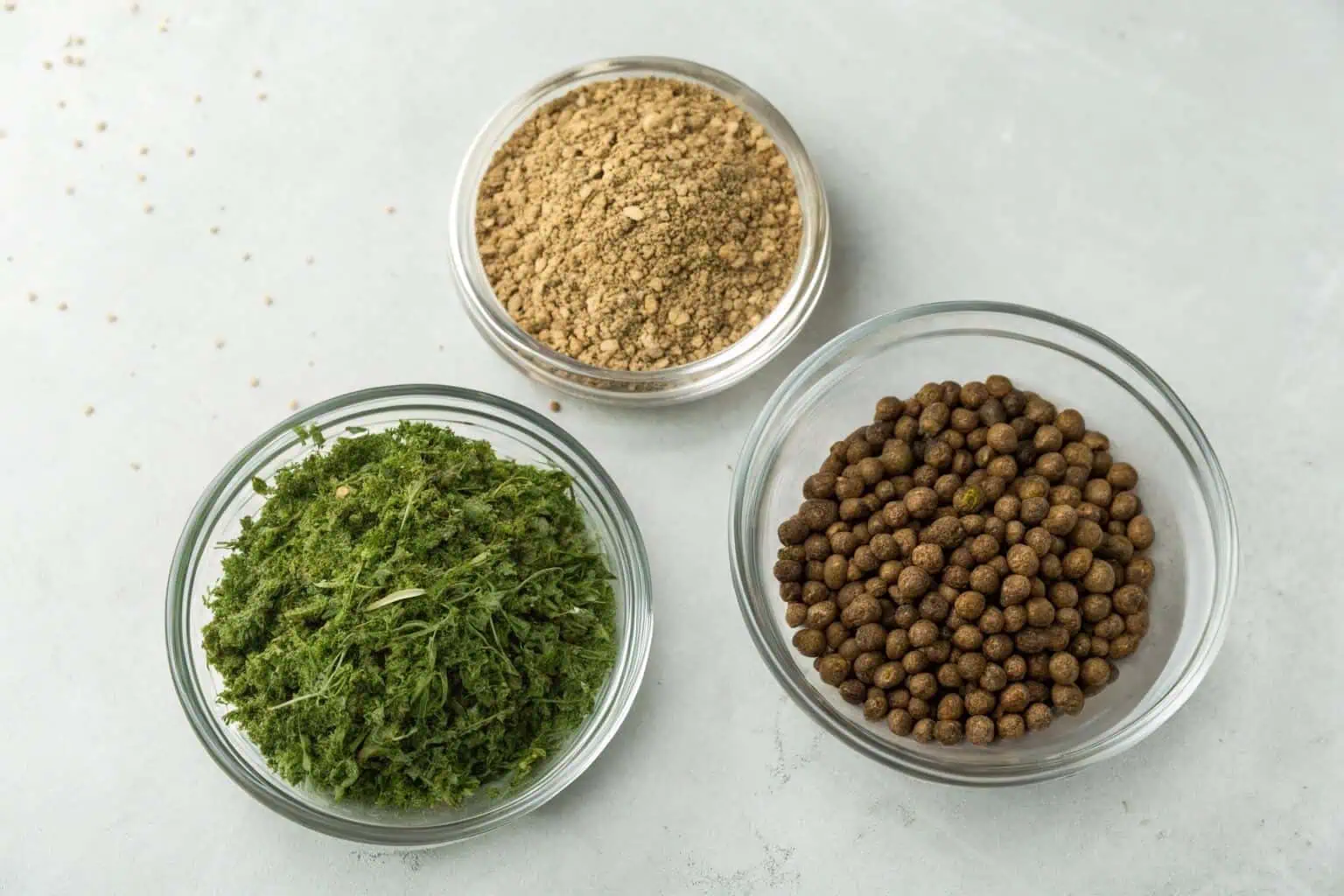
As a fish farmer, I've learned that what my fish eat is the cornerstone of my entire operation. It’s more than just food; it’s the fuel for growth, health, and ultimately, my business's success. Now that you know the basic categories, you're probably wondering what the real differences are and which one is right for your farm. Let's dive deeper into each type to help you make a more informed decision for your fish.
What are the three types of fish feed?
Feeling lost trying to choose between natural, supplementary, or complete feeds? This decision is critical, as it directly impacts your fish's growth rate and your farm's overall profitability. Let's clarify them.
The three types are natural, supplementary, and complete feeds. Natural feed is found in the pond. Supplementary feed adds to the natural diet. Complete feed provides all necessary nutrients, making it ideal for high-density farming where natural food is scarce.
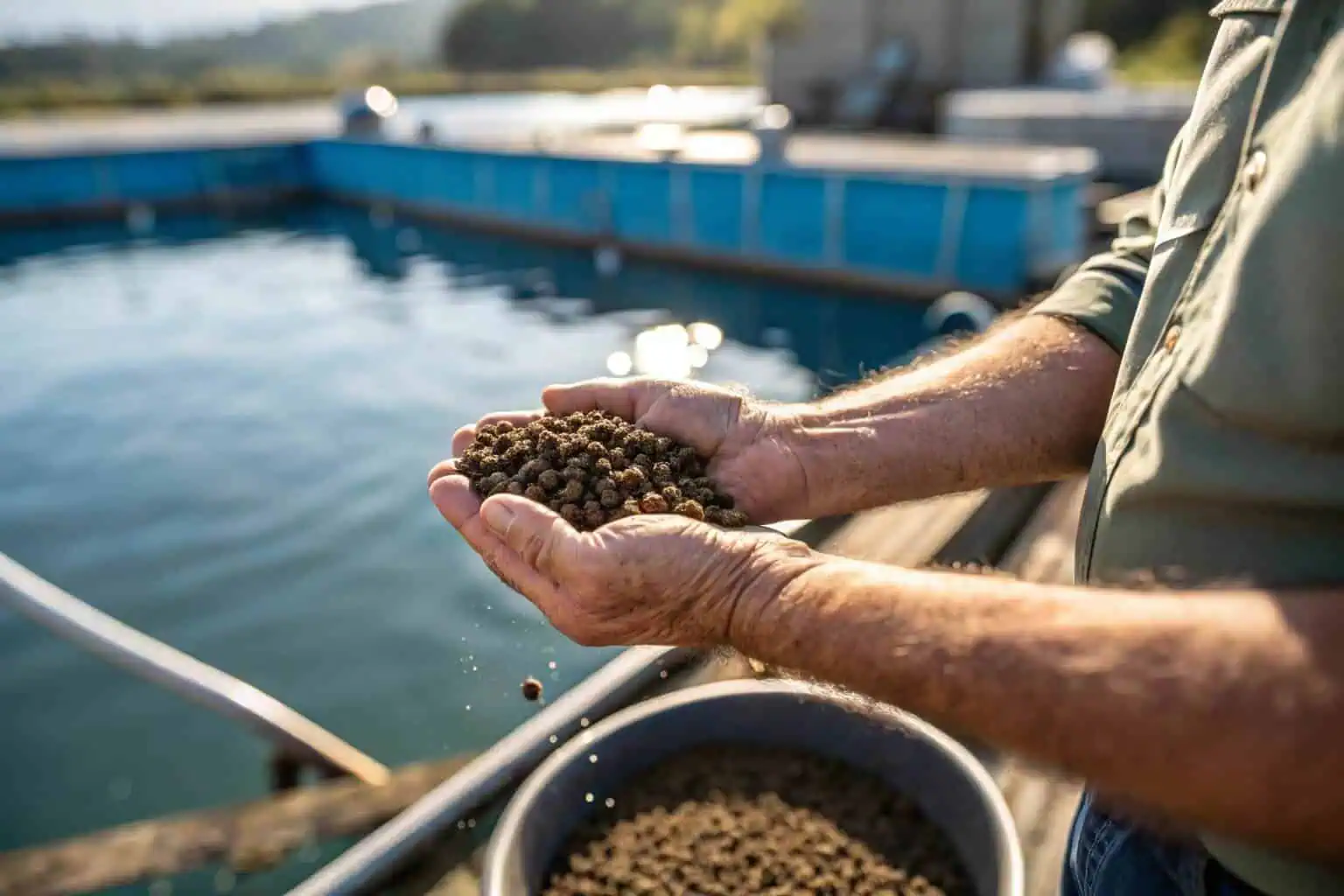
In my years of farming, I've worked with all three, and each has its place. The choice isn't always about which one is "best" but which one is right for a specific situation. To really get a handle on this, we need to break down what each type offers and where it shines. I've found that a clear understanding here is the first step toward a more efficient and sustainable farm1. Let's look at the details.
Natural Feed
Natural feed is the food that already exists in the water. This includes everything from microscopic algae and zooplankton to small insects and aquatic plants. In a natural, low-density environment like a traditional pond2, fish can often survive and grow on this alone. The biggest advantage is the cost—it's free. However, relying solely on natural food is risky in a commercial setting. The quantity and nutritional quality can vary wildly depending on the season, water quality, and weather. For a modern farm with many fish in a small area, like one of our collapsible fish tanks, there simply isn't enough natural food to go around.
Supplementary Feed
This is where supplementary feeds3 come in. These are feeds that are meant to complement, not replace, the natural food in a pond. Think of them as a nutritional boost. Common examples include agricultural by-products like rice bran, wheat middlings, or oil cakes. They are generally less expensive than complete feeds and can be a great way to improve growth rates without breaking the bank. I've used them in semi-intensive systems where fish have access to some natural food but need extra energy and protein to grow faster. The downside is that they aren't nutritionally complete. Relying on them too heavily can lead to deficiencies and health problems down the line.
Complete Feed
Complete feeds are the standard in modern, intensive aquaculture. These are carefully formulated and manufactured feeds, usually in pellet form, that provide everything a fish needs to thrive: protein, carbohydrates, fats, vitamins, and minerals. They are designed to be the sole source of nutrition. This is what I rely on for my high-density tanks. The main benefit is control and predictability. With a complete feed, I know my fish are getting a balanced diet every single day, which leads to consistent, optimal growth. The primary drawback is the cost. These feeds are the most expensive option, so managing their use efficiently is key to profitability.
| Feed Type | Primary Components | Best For | Key Advantage |
|---|---|---|---|
| Natural Feed4 | Algae, zooplankton, insects | Low-density ponds | Low cost |
| Supplementary Feed | Agricultural by-products | Ponds with some natural food | Balances diet cheaply |
| Complete Feed5 | Processed, balanced nutrients | High-density tanks/cages | Optimal, predictable growth |
What are the different forms of fish feeds?
Does the physical shape and size of the feed actually matter? Absolutely. Using the wrong form can lead to uneaten food, which means wasted money and polluted water. Let's look at the common forms.
Fish feeds come in several forms, mainly floating pellets, sinking pellets, and fine crumbles or powders. The right choice depends entirely on the fish species' natural feeding habits—whether they eat at the surface, in the middle, or at the bottom—and their age.
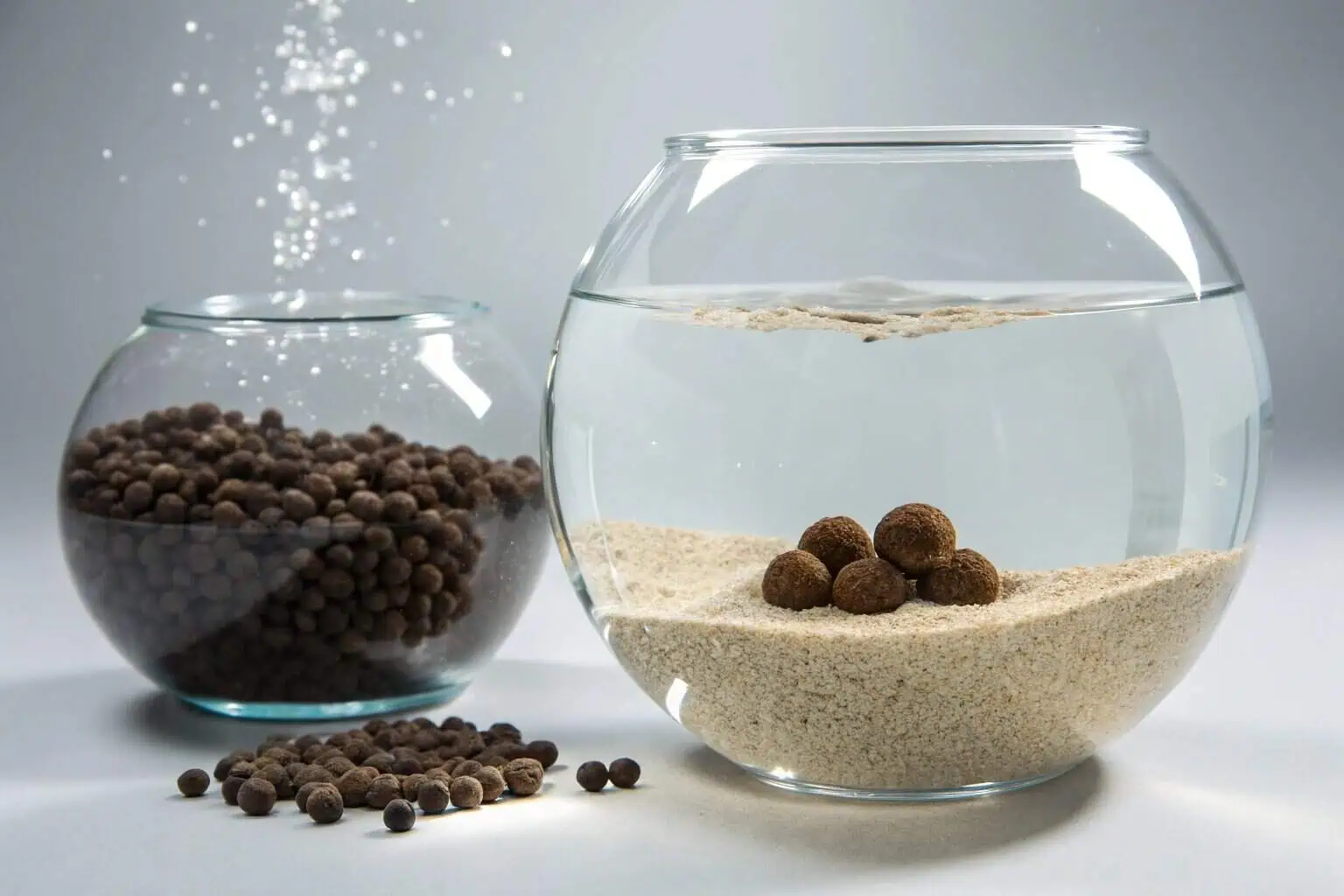
Choosing the right form of feed is just as important as choosing the right nutritional content6. I learned this the hard way when I first started. I was feeding sinking pellets to a species that preferred to eat at the surface, and I couldn't figure out why my feed costs were so high and my water quality was so poor. It turned out most of the feed was just rotting at the bottom of the tank. Understanding the different feed forms and matching them to your fish is a simple change that can have a huge impact on your farm's efficiency.
Floating Pellets
As the name suggests, these pellets float on the water's surface for an extended period before they slowly break down. This is a huge advantage for farmers because it allows us to directly observe the fish as they eat. We can see how actively they are feeding, which is a great indicator of their health. It also helps prevent overfeeding, as we can stop adding feed as soon as the fish lose interest. This reduces waste and helps maintain good water quality. Floating pellets are perfect for surface-feeding species7 like tilapia and trout. They are often processed using a method called extrusion, which cooks the ingredients and can make them more digestible for the fish.
Sinking Pellets
Sinking pellets are denser and drop to the bottom of the tank or pond as soon as they hit the water. This makes them the ideal choice for bottom-dwelling species8 like catfish, carp, and shrimp, which have mouths adapted for feeding on the substrate. For these animals, a floating pellet would be unnatural and difficult to eat. While you can't observe the feeding activity as easily, sinking pellets ensure that the food gets to where these specific fish are. The key is to be very careful with the feeding amount. Since you can't see the leftover food, it's easy to overfeed, which can lead to wasted feed and serious water quality problems from the decomposing pellets.
| Feed Type | Buoyancy | Ideal for | Benefits | Challenges/Considerations |
|---|---|---|---|---|
| Sinking Pellets9 | Sink | Bottom-dwelling species (catfish, carp, shrimp) | Reaches fish adapted to feeding on the substrate | Difficult to observe feeding activity, requires careful feeding amount to avoid overfeeding |
Crumbles and Powders
When fish are very young—in the larval or fry stage—their mouths are far too small to handle even the smallest pellets. This is where crumbles and powders are essential. These are finely ground feeds that are either suspended in the water column or spread across the surface. They provide the critical nutrition that young fish need during their most vulnerable life stage. As I've experienced with my own hatchery, getting the feeding right for fry is a delicate balance. You need to provide enough food for them to grow, but because the particles are so fine, overfeeding can quickly foul the water10. I often have to feed small amounts multiple times a day to ensure the fry get what they need without ruining their environment.
What are the three methods of feeding fish?
Are you still just tossing food into the water and hoping for the best? Your feeding method could be costing you money and limiting your fish's growth. Let's explore smarter ways to feed.
The three main feeding methods are hand feeding, demand feeding, and automatic feeding. Hand feeding offers maximum control, demand feeding lets fish eat when they are hungry, and automatic feeders provide consistent, scheduled meals for ultimate efficiency.
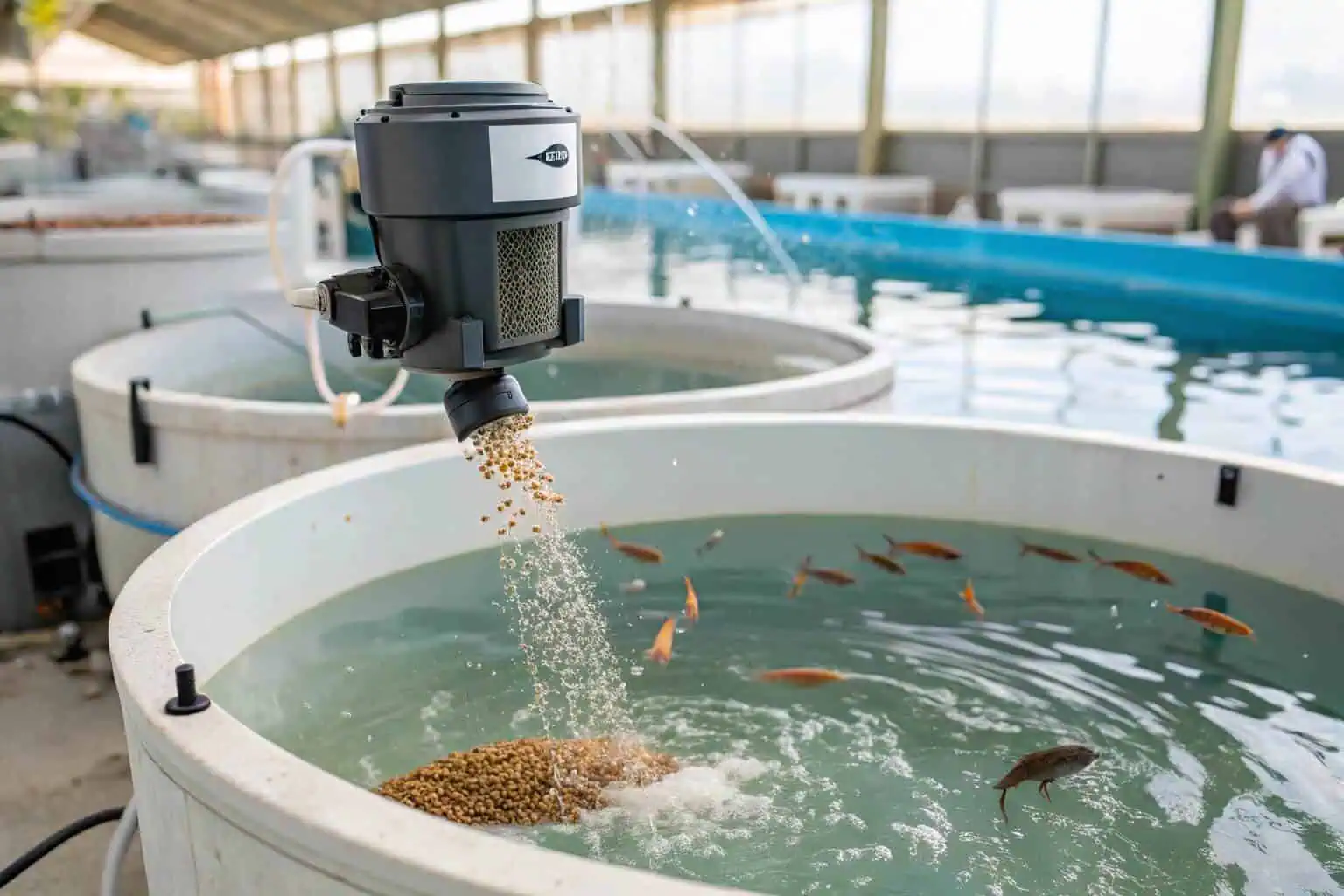
How you deliver the feed is a critical piece of the puzzle. It’s not just about what you feed, but how you do it. The right method can improve your feed conversion ratio (FCR)11, which is the measure of how efficiently your fish turn feed into body mass. A better FCR means less wasted feed and more profit. Over the years, I've used all three methods, and each has its own set of pros and cons that make it suitable for different situations.
Hand Feeding
Hand feeding is the most basic method. It involves manually broadcasting the feed across the surface of the water at set times. The biggest advantage of hand feeding12 is that it puts me right there with my fish every day. I can check their behavior, see how aggressively they are eating, and spot any signs of disease or stress early on. This daily observation is invaluable. It also gives me complete control to adjust the feed amount on the spot if the fish seem less hungry or if the weather changes. However, hand feeding is very labor-intensive, especially on a large farm. It can also lead to inconsistent feeding if different people are doing it or if schedules aren't followed strictly.
Demand Feeding
Demand feeders are simple devices that allow the fish to feed themselves. The feeder has a container for the feed and a trigger mechanism13, like a pendulum or a rod, that extends into the water. When the fish are hungry, they learn to nudge the trigger, which releases a small amount of feed. This method is great because it ensures fish are fed according to their actual appetite, which can reduce waste. It's a low-tech form of automation that doesn't require electricity. The downside is that it doesn't work for all species, as some fish never learn to use the trigger. It can also be difficult to monitor how much feed is being consumed, and dominant fish might hog the feeder, preventing smaller fish from eating.
Automatic Feeding
Automatic feeders14 are a game-changer for modern aquaculture. These devices use a timer and a dispenser to automatically release a pre-set amount of feed at scheduled times throughout the day. As I've found, their biggest benefit is the massive reduction in labor. They also provide incredible consistency. Small, frequent meals throughout the day are often better for fish growth and FCR than one or two large meals. Sometimes I try to use automatic feeding equipment to improve efficiency, but the initial investment makes me have to consider it carefully. There's also the risk of malfunction—a broken feeder could mean your fish go unfed, or a stuck one could dump a whole bag of feed, creating a costly mess.
| Equipment Type | Mechanism | Key Benefits | Considerations/Drawbacks |
|---|---|---|---|
| Automatic Feeders | Timer and dispenser automatically release feed | Massive reduction in labor, incredible consistency15, facilitates small frequent meals | Initial investment costs, risk of malfunction (underfeeding or overfeeding due to error) |
What do fish farmers actually feed their fish?
Ever wonder what's really on the menu at a commercial fish farm? It's rarely a single thing. The daily feed is a careful calculation based on science, experience, and business sense.
Fish farmers use a strategic combination of feeds based on the fish species, its age, the farming system, and financial goals. The aim is always to find the sweet spot that balances rapid growth, robust health, and manageable costs for a sustainable operation.
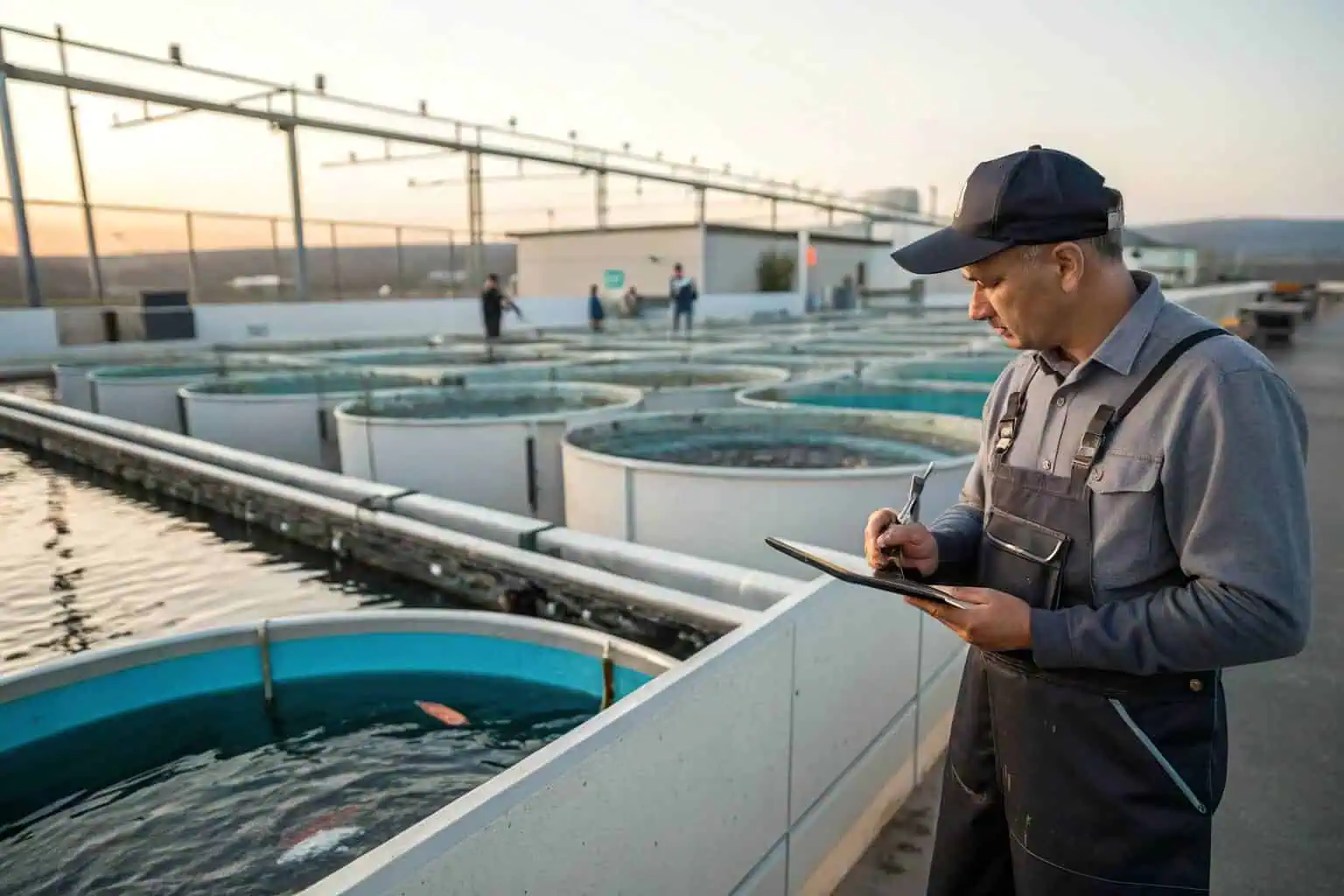
In my day-to-day work, the question isn't just "what feed to use?" but "what feed to use today, for this group of fish, in this tank?" The answer is always changing. Running a successful fish farm is a dynamic process16. We are constantly adjusting our feeding strategies to respond to the needs of our fish and the demands of the market. It's a blend of science from feed manufacturers and the practical art of animal husbandry that you only learn from experience.
A Farmer's Daily Decision
On any given day, I'm making decisions that directly impact my bottom line. For fish in my earthen ponds, I might rely on the natural food available and supplement it with a lower-cost feed to boost growth. But for the fish in my Bancy collapsible fish tanks, where the density is much higher, I use a high-quality complete feed17 exclusively. These tanks are closed systems, so the fish are 100% reliant on what I provide. For my fry and juvenile fish, I use a specialized starter feed that's high in protein to fuel their rapid development. As they grow, I'll transition them to a less expensive grower feed. It's a constant process of matching the feed to the fish's life stage.
Balancing Cost and Quality
As I know all too well, artificial feed is nutritionally balanced, but the cost needs to be weighed. Feed is often the single largest operational expense on a fish farm, sometimes accounting for over 50% of the total cost of production. So, while a high-protein, high-performance feed might produce the fastest growth, it might also be too expensive to be profitable. Many farmers, including myself, use a strategy where we feed a very high-quality diet during the critical early growth stages, and then switch to a more economical feed as the fish approach market size. It's about finding the most cost-effective way to get the fish to the target weight18 without sacrificing their health.
Special Feeds for Special Needs
There are also times when I need to use special-purpose feeds. For example, if I notice signs of a bacterial infection starting in a tank, I might use a medicated feed that contains an antibiotic. This is a targeted way to treat the fish without having to treat the entire water volume. Similarly, during periods of stress, like after moving fish to a new tank or during extreme temperatures, I might use a feed fortified with extra vitamins and immune-stimulants to help boost their resilience. As I've learned, this kind of special feed is my best choice when the fish are sick or need special care. It's a critical tool for proactive farm management.
| Feed Type | Purpose/Application | Mechanism/Benefit | When to Use | Importance |
|---|---|---|---|---|
| Medicated Feed19 | Treating bacterial infections | Contains antibiotics, targets fish without treating water | When signs of bacterial infection are observed | Targeted treatment, proactive farm management |
| Fortified Feed20 | Boosting resilience during stress | Contains extra vitamins and immune-stimulants | During stress (moving, extreme temperatures) | Supports fish health, proactive farm management |
| Special-Purpose Feeds | Addressing specific health or stress needs | Tailored nutritional content | When fish are sick or need special care | Critical tool for proactive farm management |
Conclusion
Choosing the right feed and feeding method is fundamental to your success. By understanding the types of feed, their forms, and how to deliver them, you can improve fish health and boost farm profitability.
-
Explore this resource to discover essential strategies and practices that can enhance your farming efficiency and sustainability. ↩
-
Learning about traditional ponds can provide insights into sustainable fish farming methods and their advantages. ↩
-
Explore this link to understand how supplementary feeds can enhance fish growth and health in aquaculture systems. ↩
-
Explore the advantages of Natural Feed, including its cost-effectiveness and suitability for low-density ponds. ↩
-
Discover how Complete Feed provides optimal growth conditions in high-density environments, ensuring predictable results. ↩
-
This link will provide insights into the importance of nutritional content in fish feed, crucial for optimizing growth and health. ↩
-
Learn about various surface-feeding fish species and how they benefit from specific feeding strategies. ↩
-
Learn about various bottom-dwelling species and their feeding habits to better understand their dietary needs and improve your fish care. ↩
-
Explore the advantages of Sinking Pellets to enhance your fish feeding strategy and ensure optimal growth. ↩
-
Learning about the effects of overfeeding can help you maintain a healthy aquatic environment for your fish. ↩
-
Understanding FCR is essential for optimizing fish farming practices and improving profitability. Explore this link for in-depth insights. ↩
-
Explore the advantages of hand feeding fish, including daily observation and control over feeding amounts, which can enhance fish health. ↩
-
Learn about various trigger mechanisms in fish feeders to choose the best option for your aquatic pets. ↩
-
Explore the advantages of automatic feeders in aquaculture, including labor reduction and improved fish growth. ↩
-
Discover how Automatic Feeders ensure your pets receive their meals on time, promoting better health and routine. ↩
-
Learn how the dynamic nature of fish farming impacts management and success, providing insights for better practices. ↩
-
Exploring this resource will help you understand the advantages of using high-quality feed for optimal fish growth and health. ↩
-
Discover effective strategies that balance cost and fish health to maximize profitability in your fish farming operations. ↩
-
Explore how Medicated Feed can effectively treat bacterial infections in fish, ensuring better health and management. ↩
-
Learn about the advantages of Fortified Feed in enhancing fish resilience during stressful conditions. ↩